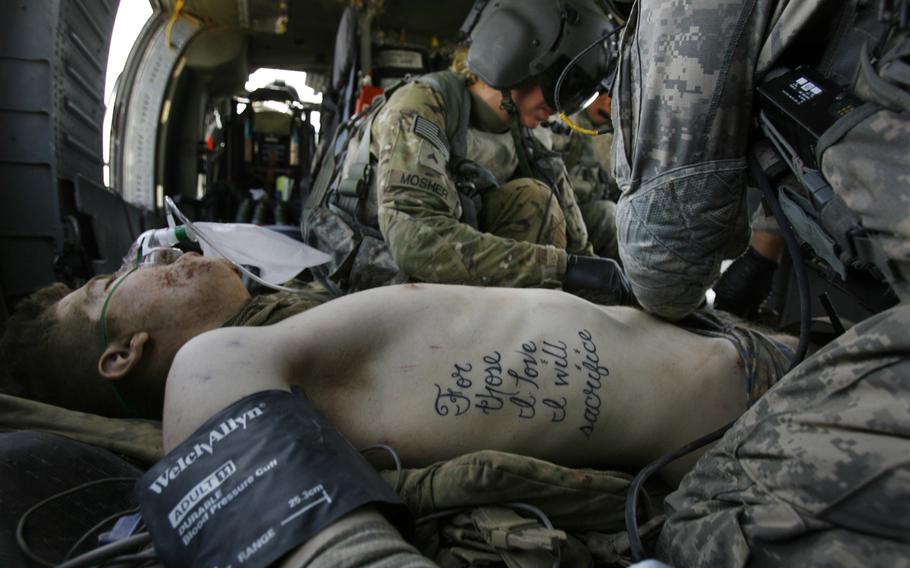
Pfc. Kyle Hockenberry, of 4th Squadron, 4th Cavalry Infantry Regiment, 1st Heavy Combat Brigade, 1st Infantry Division, who was injured in an improvised explosive device attack near Haji Ramuddin, is treated by flight medic Cpl. Amanda Mosher while being transported by medevac helicopter to the Role 3 hospital at Kandahar Air Field in Afghanistan on June 15, 2011. Throughout Hockenberry’s multiple surgeries and skin grafts, doctors have worked around his tattoo and left it intact. (Laura Rauch/Stars and Stripes)
This article first appeared in the Stars and Stripes Mideast edition, Aug. 26, 2011. It is republished unedited in its original form.
FORWARD OPERATING BASE PASAB, Afghanistan — It was the worst of places, but the soldiers on the ground had few options when they marked the landing zone for the medevac helicopter. One of their buddy’s legs had been blown off by an IED near Pashmul South, and another had suffered a traumatic brain injury from the blast.
Grape rows, tree lines and mud walls surrounded the field. It was the perfect setting for an ambush.
Purple smoke billowed from the landing zone as the crew of Dustoff 59 sped toward a small band of the 1st Infantry Division soldiers, waiting with their wounded. As pilot and Chief Warrant Officer 2 Marcus Chambers slowed for the landing, gunfire broke out and the all-too-familiar tat-tat-tat, tat-tat-tat pinged around them.
Chambers set the aircraft down and flight medic Staff Sgt. Garrick Morgenweck flung the door open to retrieve the wounded. As he stepped out, insurgents fired a rocket-propelled grenade from close range, striking a mud wall and narrowly missing the helicopter as it blasted through.
Pilot in command Capt. Chris Morisoli immediately called the crew back in and told Chambers to take off. Morgenweck fell backward into the cabin, pulling the door shut as Chambers steadied the aircraft while the crew struggled to strap in.
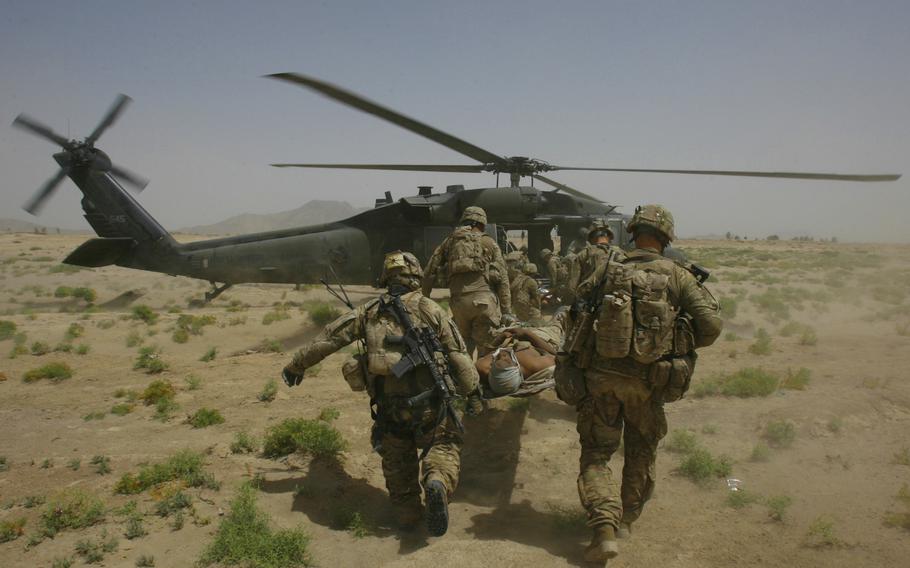
Sgt. William Bennett of 1st Battalion, 5th Infantry Regiment, 1st Stryker Brigade Combat Team is evacuated to a medevac helicopter after being injured in an improvised explosive device attack near Molla Dust in Kandahar province, Afghanistan, on June 15, 2011. (Laura Rauch/Stars and Stripes)
The helicopter darted into the sky, forcing the crew to leave the soldiers on the ground. Dustoff 59 circled out of range while an Apache gunship fired on insurgents. Chambers followed the Apache in, but a second RPG was fired. It missed the aircraft, but the blast wave shook the cabin.
Frustration gripped the crew as Chambers circled for a third attempt. But insurgents attacked with a barrage of small-arms fire, which shook the rotor system and nearly hit crew chief Staff Sgt. Bruce Garrett. A bullet passed just inches from his chest, knocking a ballistic plate into his knees and sending bullet fragments throughout the cabin. A spray of shrapnel caught Morgenweck in the face. Again they charged away.
Morisoli checked in with the crew. They’d all seen enough of this war to know that the soldier whose legs had been blown off stood little chance of survival if he didn’t get to a surgeon soon. Without discussion, each crewmember voted for a fourth attempt.
Morisoli took the controls and followed in fast on yet another gun run by the Apache. The crew watched as soldiers huddled over the wounded, trying to protect them.
As Morisoli closed in, he pulled up and rotated the aircraft by shifting into an unexpected decelerating turn over a mud wall, landing the nose of the helicopter just four feet from the wounded. If they weren’t under attack, he would have never landed so close. Gunfire erupted.
One last explosion blew in the distance. Morgenweck covered flight medic Cpl. Amanda Mosher with his M4 as she pushed out of the aircraft and guided the wounded on board.
Forty seconds later, Dustoff 59 lifted off.
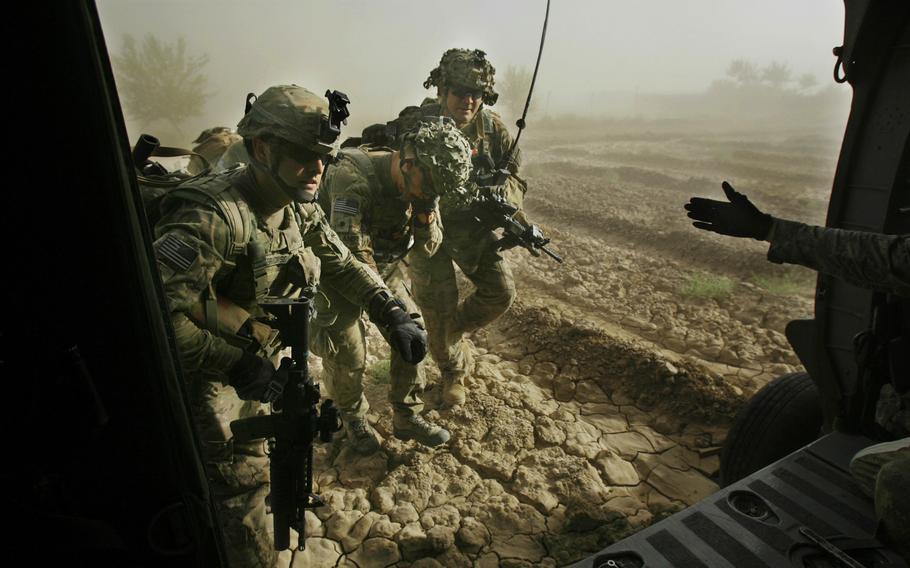
Spc Mitchel Holland, of 4th Squadron, 4th Cavalry Regiment, 1st Heavy Combat Brigade, 1st Infantry Division is helped on to a medevac helicopter after being injured just east of Sangasar on June, 15, 2011, in Kandahar province Afghanistan. (Laura Rauch/Stars and Stripes)
The ‘golden hour’
As coalition forces push into the Arghandab River Valley, and Taliban reprisals exact their toll on U.S. and Afghan soldiers, Dustoff crews from Company C, 1st Battalion, 52nd Aviation Regiment, 16th Aviation Brigade, fly throughout the Kandahar province, pulling the wounded from the battlefield.
Their work revolves around the medical “golden hour,” the fleeting 60 minutes that critically wounded have to receive surgical care before their chances of survival begin to dwindle rapidly.
“It is a no-fail mission. If we don’t fly, they don’t live,” pilot and Chief Warrant Officer 4 Stephanie Truax said. “When it’s your time, it’s your time. I don’t think any of us worry about dying. It’s what we see, day in and day out. War is hell.”
When Truax flies, she sees her sons, who are 18 and 19.
“For me, it’s close,” she said, fighting back tears, “When I pick up the guy and he’s missing his legs, he looks just like my son, and my son is a Marine.”
Though crewmembers are immensely diverse in personality and upbringing, they are bound by their ability to remain calm under unimaginable duress. When faced with adversity, they find clarity, becoming more focused as the mission toughens.
They fly low and fast and always unpredictably when retrieving the wounded. While their aviation methods appear chaotic, each decision is thoughtful, every flying maneuver deliberate. They depend on the speed and agility of their workhorse, the UH-60A Black Hawk, to get in and out of hot zones quickly.
“You turn that aircraft into an extension of your own body and you just fly it,” said Morisoli, who is also the executive officer for the company.
While on duty, crews are never more than a few hundred yards from their aircraft, which is preset for flight. Everything is arranged for speed. Gloves are left just so; body armor hangs where it can’t get tangled. Some sleep in their clothes. Rarely do they get too comfortable in one spot. They read and watch movies, play video games and laugh. Practical jokes abound.
They can wait for hours — sometimes days — for a call, but when “medevac, medevac, medevac” cracks over the radio, they tear toward their aircraft, leaving whatever task was at hand in a pile behind them.
Though their mandate allows them 15 minutes to launch after they’ve received a 9-line, named for the nine lines of information the mission contains, they’re usually off the ground in less than seven. Their call sign, Dustoff, was first used in 1962 by a helicopter medevac crew in Vietnam.
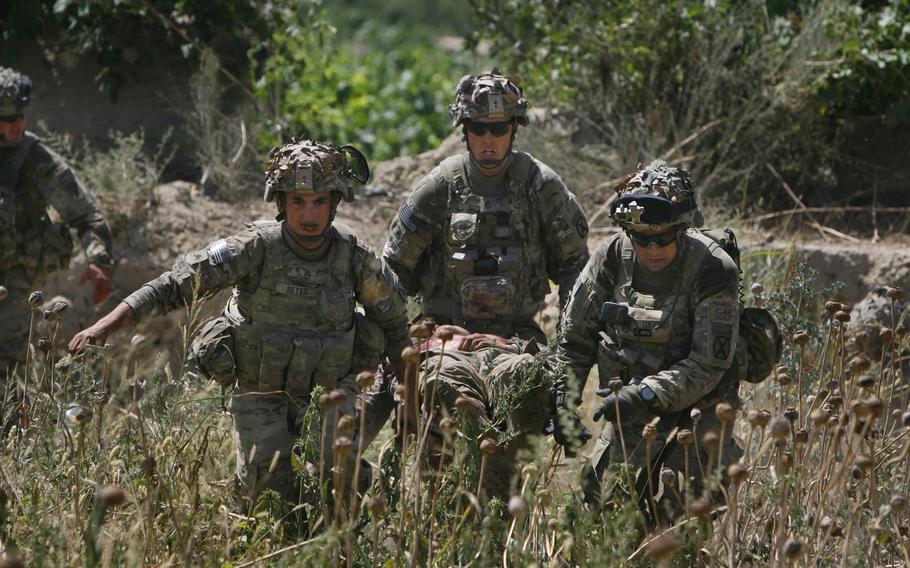
Sgt, Thomas Reyes, left, Staff Sgt. Mike Waxler, and Staff Sgt. Darren Cufaude, all of 2nd Battalion, 87th Infantry Regiment, 3rd Brigade Combat Team, 10th Mountain Division, evacuate one of several soldiers who were wounded during an improvised explosive device attack on June 18, 2011 near Pashmul North in Kandahar province, Afghanistan. (Laura Rauch/Stars and Stripes)
In 2009, then-Secretary of Defense Robert Gates issued an order requiring that medevac units transport the critically wounded in Iraq and Afghanistan to a trauma facility within an hour of receiving a call.
According to NATO-led International Security Assistance Force in Afghanistan, average flight times in Regional Commands East, South and Southwest are averaging about 39 minutes in 2011.
That’s five minutes faster than the average flight time in 2010.
A moment’s notice
During the summer months, temperatures soar in the aircraft, and the smell of fuel permeates the air. Dust landings can fill a cabin with debris and cover the flight medic and crew chief in dirt. Sweat pours from their bodies as they work over a patient while wearing a fire-repellant suit, body armor and a flight helmet. Their knees can ache from kneeling over the wounded, and spectacular bruises are commonplace.
Because the aircraft will pitch and pull in flight, especially in a hot landing zone, medics have learned to look at the floor instead of the horizon to avoid becoming disoriented while treating patients.
The vibrating cabin roars from the deafening sound of the engine and rotors, so medics, deprived of their ability to hear patients or speak to them, use sight and touch to check for breathing and simple hand gestures to communicate.
Though an armed Black Hawk follows all medevac flights, an air weapons team, usually made up of a Kiowa Warrior and Apache Longbow, often accompanies them to provide fire cover in a hot landing zone.
Sometimes, medevac crews are forced to wait for launch approval until the bigger guns arrive. Nothing about the rigors of their job can cause them more strife.
It’s the only time during a mission that the cadence of their voice changes. Even under direct fire, they’ll remain calm, but waiting for a launch approval when they know a soldier needs them can undo them like nothing else.
Recently, a crew waited at FOB Pasab. Tension filled the cabin as their helicopter sat, engines fired and rotors turning. They knew from the 9-line that a U.S. soldier had been shot in the chest. They knew he was barely breathing. But division headquarters had received reports that a firefight raged, and they wouldn’t allow the unarmed medevac to go in without an air weapons team.
The pilots know they can’t risk the crew and the aircraft by landing in a firefight without backup. If the bird goes down, they’ll become the injured instead of the rescuers. But being rational doesn’t make the waiting any easier. They’re soldiers. And soldiers take risks to help other soldiers.
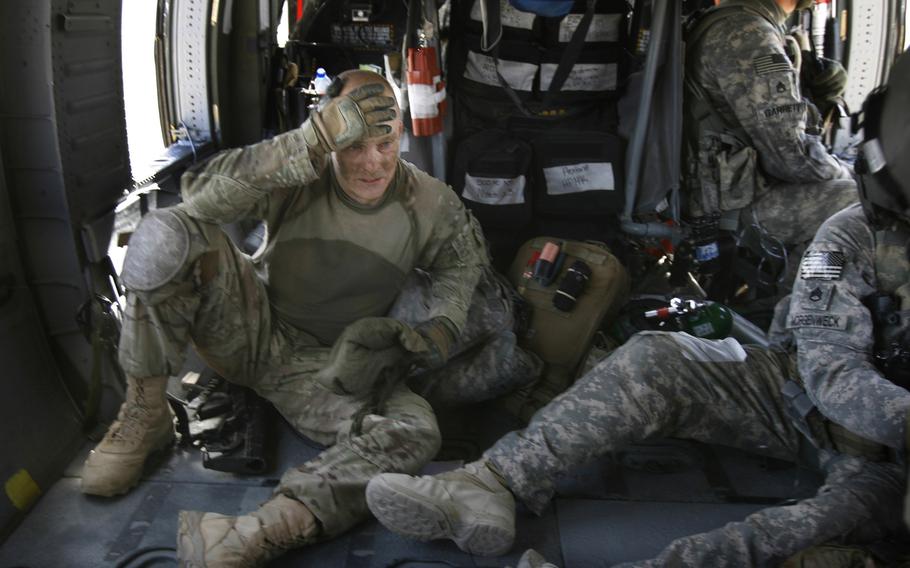
Sgt. 1st Class Jeff Johnson of Troop B, 4th Squadron, 4th Cavalry Regiment, 1st Heavy Brigade Combat Team, 1st Infantry Division, is transported by a medevac helicopter after suffering from traumatic brain injury following an improvised explosive device attack on June 20, 2011, near Pashmul South in Kandahar province, Afghanistan. (Laura Rauch/Stars and Stripes)
The same frustration occurs when they’re unable to land because of an attack.
“It’s all about those guys on the ground, so if we have to go in there 10 times, I’ve got to put my fears aside because they’re counting on me,” said Garrett, who, along with the rest of Dustoff 59’s crew, was nominated for an Air Medal with Valor for his actions under fire in Pashmul South.
“I’m counting on them to go out there to fight the Taliban head to head, in close quarters. When they need medevac, we’re going in there.”
Nearly half the casualties are Afghan soldiers or civilians. They treat enemy prisoners of war and suspected Taliban fighters with the same care they provide coalition forces. But there’s an unmistakable communion they share with U.S. soldiers.
“Those poor bastards get so beat up out there,” said flight medic Sgt. Brandon Lowther.
Sometimes, the troops on the ground have a hard time letting go of the wounded.
“You’ll have to push them away from the aircraft because they’re leaning in and want to grasp hands or get one last look at their buddy before they leave them,” Lowther said.
Like many of the soldiers, Lowther struggles to understand why Taliban insurgents fire on medevac crews. Though the Taliban are hardly signers of the Geneva Conventions, which prohibits firing on marked ambulances, Afghanistan is an original signatory of the 1949 protocol.
“I can’t wrap my mind around it, especially with the number of Afghans that I’ve picked up,” Lowther said, “It makes my brain hurt to try and process and understand what goes through their mind.”
‘A little more closer to hell’
Capt. Maureen Pennington, director of nursing services at the NATO Role 3 Multinational Hospital at Kandahar Air Field, believes that medevac crews carry a quiet burden, one they aren’t often willing to share with outsiders, and she worries about what they see.
She senses the relief they feel when they hand over a patient and notices a slight drop in their head once the trauma team takes over. She knows they’re retracing their actions and wondering whether they did everything they could.
“You can’t even imagine what they go through. I think they have the weight of the world on their shoulders with all of the soldiers that they take care of,” Pennington said, adding after a brief pause, “That responsibility must weigh very heavy on them.”
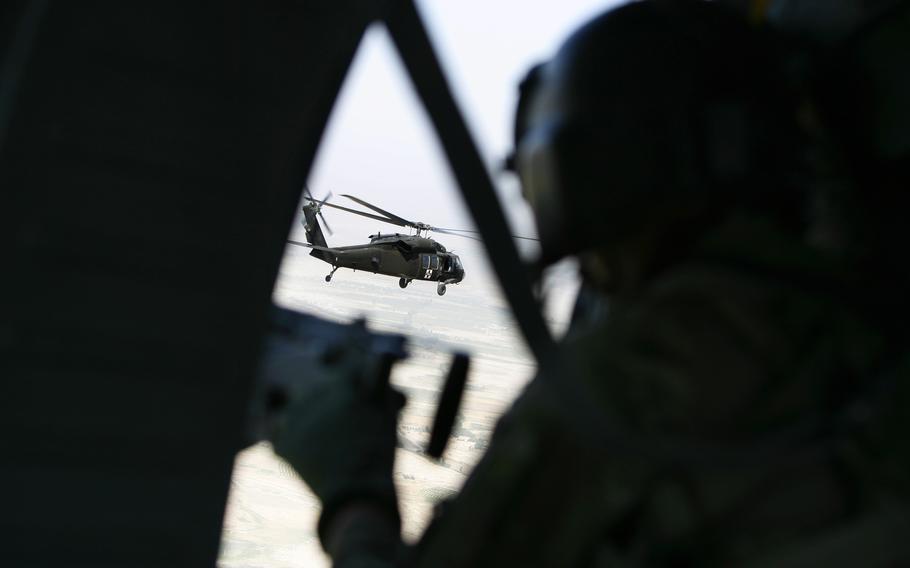
Staff Sgt. Ryan Musterman of Company A, 7th Battalion, 101st Aviation Regiment, mans a M240H machine gun while covering a medevac helicopter from the “chase” Blackhawk on June 19, 2011, in Kandahar province, Afghanistan. (Laura Rauch/Stars and Stripes)
While most of the medevac soldiers attempt to disengage their personal feelings from their work, some, like Lowther, let the swell of emotions wash over them. He can’t help but cry at times, especially when his patients are Afghan children. An endless stream of them, robbed of their childhood by poverty and war, make their way onto their helicopters.
Some have been caught in crossfire; others are simply victims of the brutal Afghan rural life.
Sometimes he calls the hospital to check on someone he’s treated. He’s one of the few who wants to know if they made it. Most can’t bear to know.
But even Lowther has a threshold. Recently, while other crewmembers were watching mission footage shot by an embedded film crew, he was overcome with a sickening pain and left the room. He can live it every day, but he can’t stand to watch it replayed.
Even those who try to disengage eventually think about what they see. Catastrophic blast injuries from IEDs that shred a body like nothing else. Gunshot wounds that cause a man to writhe as he pleads with a medic to help him breathe or give him water.
Sometimes, the pain in the eyes of the soldiers gets to Morisoli.
He thinks about the journey they’ll have trying to put their life back together. He thinks about the families that will welcome them home. He can’t linger in his thoughts too long, though, because he knows that in the end, it just hurts too much.
He has to let go because he knows that tomorrow, or the next day, he and his crew will pick up another soldier who has lost his legs.
“This is a rough game, and I don’t care who you are, it’s going to affect you,” Role 3 hospital commander Capt. Mike McCarten said.
“They’re seeing things a little more closer to hell.”